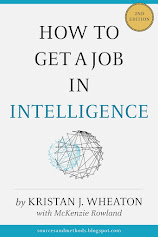 |
| An example of starting positions for DMZ. |
Last week was Battle Week in my Strategic Intelligence class. Using DMZ, Decision Games recently released tabletop wargame that simulates an invasion of South Korea by North Korean forces sometime in the near future, my 20 students duked it out over the Taebaeck Mountains and Cheorwon River Valley for nearly four hours.
The results? The rules give a "win" to the North Koreans if they can take and hold Seoul. Those same rules call it a draw if North Korean forces can take Seoul but not hold it. In the 10 games we played, the North Koreans were only able to take and hold Seoul once while they managed 2 draws.
Obviously, the purpose of this exercise was not to predict the future. I wanted to get my students to think about strategy and the impact of intelligence on strategy. In order to encourage this kind of thinking, I had them outline what they thought their opponent's strategy would be and then detail their own strategy before they began the game
At the end of the game, I also asked them to consider how well they had been able to estimate their opponent's strategy and how well they had executed their own strategy.
While I am still crunching all this data, one of the most interesting results came out of my students' predictions about the outcome. I wanted to know which side the students' thought would win. I also wanted to check for bias so I asked this question two different ways.
First, I asked who would win, "me" (the student filling out the survey) or "my opponent" (the student they were playing against)? Only three of the 10 North Korean players predicted victory while none of the South Korean players predicted a North Korean victory.
Next, I asked, out of the 10 games to be played, how many times would the North Koreans win? While the range was from 1 to 4, the average was 2.25 games.
While the level of understanding of the game and the rules varied among the players, if I give a half point to a draw (which I am inclined to do...), both the individual predicted average and the collective average indicates a high degree of calibration on the part of these student analysts -- an encouraging result, for me, at least.





